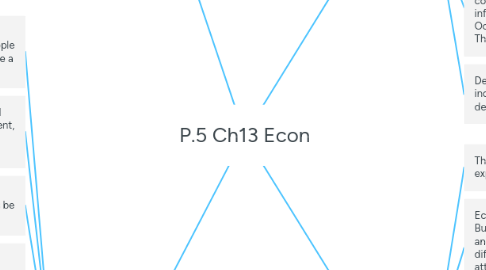P.5 Ch13 Econ
af Dominick Beckman


1. 13.4
1.1. Tracking Inflation with the Consumer Price Index: Economists at the BLS track changes in the cost of living using what is known as the consumer price index. A price index measures the average change in price of a type of good over time. The consumer price index (CPI) is a price index for a “market basket” of consumer goods and services.
1.2. Adjusting for Inflation: Nominal vs. Real Cost of Living: The real cost of living is the nominal cost of basic goods and services, adjusted for inflation.
1.3. Creeping Inflation, Hyperinflation, and Deflation: In the United States we have come to expect a certain amount of gradual inflation, or creeping inflation, every year. Occasionally inflation goes into overdrive. The result is hyperinflation.
1.4. Demand-Pull vs. Cost-Push Inflation: This increase in overall demand results in demand-pull inflation.
2. 13.5
2.1. The Four Phases of the Business Cycle: expantion, peak, contraction, trough
2.2. Economic Indicators and the Business Cycle: Business cycles are irregular in both length and severity. This makes peaks and troughs difficult to predict. Nonetheless, economists attempt to do just that, using a variety of economic indicators.
2.3. From Boom to Bust to Boom Again: Business cycles are popularly known as periods of boom and bust. A boom is the expansion phase of the cycle.
2.4. Indicators: Leading indicators., Coincident indicators,Lagging indicators.
2.5. Key Term: Leading indicators, Measures that consistently rise or fall several months before an expansion or a contraction begins are called leading economic indicators.
3. 13.2
3.1. Gross Domestic Product: what an economy produces in a year or set time frame.
3.2. How Economists estimate GDP: C+I+G+Xn
3.3. Adjusting for inflation: nominal Vs. Real GDP
3.4. Adjusting for population: Per Capita GDP
3.5. Key Term: Gross Domestic Products or GDP is the amount of products a nation produces in the term of one year.
3.6. Key Term: Market Value is the price that buyers are willing to spend or pay for a good or service in a competitive market.
3.7. Key Term: Nominal GDP measures the output of an economy valued at today's prices.
3.8. Key Term: Real GDP measures an economy not in current dollars but in constant dollars.
4. 13.3
4.1. Key Point How Government Measures Unemployment- unemployment is people who are looking for work but don't have a job.
4.1.1. Project specifications
4.1.2. End User requirements
4.1.3. Action points sign-off
4.2. Four types of unemployment: Frictional Unemployment, structural unemployment, seasonal unemployment, and cyclical unemployment.
4.2.1. Top Priorities
4.2.2. Medium Priorities
4.2.3. Low Priorities
4.3. Full employment and the natural rate of unemployment: some people will always be out of work even with 0 unemployment.
4.3.1. Top Priorities
4.3.2. Medium Priorities
4.3.3. Low Priorities
4.4. Problems with unemployment as an indicator for economic health: that at any one time, a number of unemployed people have given up looking for work, the official unemployment rate does not recognize involuntary part-time workers, and a problem with the unemployment rate involves people working in informal or underground economies.
4.4.1. Top Priorities
4.4.2. Medium Priorities
4.4.3. Low Priorities
